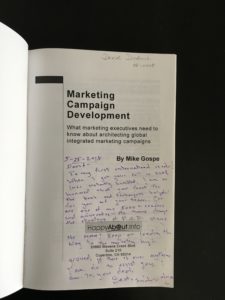The cure for “marketing popcorn”
Mike: What was it about the book that caught your interest?
David: In 2008, my background was mostly in product management. I was fortunate enough to have worked with great talents and with well established processes, managing many products from concept and definition all the way to launch and beyond. With that in mind, it actually bothered me that companies often approached “marketing campaigns” in a much less organized fashion. I noticed that marketing teams often even skipped completely over the most relevant parts of campaign management and rushed to execute a singular, one-off activity where no one knew at the end if that activity was successful or not. You call this “marketing popcorn“.
My wish was to not only bring more structure into the campaign management function, but to create marketing plans that have a measurable business impact. So, I started to look for resources that could help me help reshape marketing launches. I very quickly found your book. In fact, it was like you wrote the book for me. It wasn’t theory. It was practical and action-oriented.
Mike: That was 10 years ago. Obviously, the marketer’s world has changed since then. Is the book still relevant?
David: Yes, absolutely! There were quite a few revelations for me when working my way through the process that you outlined. Now looking back after 10 years, three things still stick out for me:
1: Understand your objectives
You have to be clear about what you are doing and why you are doing it. Of course, it’s all about generating more revenue. But such a goal alone is not useful when designing your campaign plan. You have to go through the effort of also understanding your true marketing objectives, not just your sales targets. This requires discipline because the sales team is always banging on our door to deliver more leads, today, right now!
Marketing Campaign Development provides great guidance about identifying and clarifying your marketing objectives and your go-to-market strategy. This is extremely important because action needs to follow strategy. Action without strategy leads to frustration and disappointment. Too often, marketers race to write another blog post, attend another trade show, design another advertisement without really thinking about how, when, where, and why these pieces need to integrate. There is no marketing blueprint. For example, a marketing blueprint for nurturing your installed base will look quite different than a marketing blueprint designed to challenge a competitive threat, or a blueprint designed to create thought leadership. While technology will evolve, basic marketing objectives don’t. When today’s marketers get distracted with the latest trend, it’s good to go “back to basics”. While the execution plan will look different today than it did 10 years ago, the strategic approach to marketing planning is still worth following.
2: Be clear about the value you deliver
Engineering-driven companies tend to focus on product features and benefits (a view from the inside out) rather than describing how they can help solve a customer problem (a view from the outside in). This leaves your audience with the task to make the connection themselves. In today’s over-communicated environment this is an effort many prospects are no longer willing to take. Therefore, you have to be crystal clear with your messaging. And for your messaging to be relevant, it must map to the customer’s buying journey. We need to speak the customer’s language and avoid inward-focused, technobabble. Of course, this is particularly challenging with complex products and services in the Tech Industry.
I found the value proposition template in your book to be one of best, most helpful tool for me and my team. This template looks simple at first sight and invites you to fill it out quickly. But it continues to be a humbling exercise for us because if you are not careful, you end up with trivial content. Questions that we continue to wrestle with today include: who are our best customers and prospects? What problems do they have that we can help them solve? What value are we able to provide that is unique or better than any competitive alternative? These were the questions I wrestled with 10 years ago; I am wrestling with them today; and we as marketers will continue to wrestle with them 10 years from now. This is one reason why the book is so relevant today.
3: Communicate what you do
Especially when a company is under pressure, it is crucial that the marketing department is clear about their plans. And these plans must be aligned with the sales department and their goals. In fact, these plans must be aligned and supported across the organization. I have seen many cases where activities pop up here and there and no one saw it coming. Apparently, these activities were not part of broader plan but more the results of some individuals who wanted to demonstrate action. Worse, these actions surprised our colleagues in other departments. It goes back to the marketing popcorn analogy. The point here is that we must be aligned, and we (as marketers) must own communicating our plans internally so there are no surprises. Any and all of our activities can be much more effective if they are made part of a bigger campaign plan. Marketing Campaign Development provides great guidance for alignment and internal communication and offers a valuable tool with the seven types of campaign blueprint concepts.
Advice for the new generation of marketers
Mike: What advice would you give your younger self as a marketer?
David: Don’t be tempted to take short-cuts. Instead, surround yourself with resources and materials that can help you achieve the “marketing high ground” — a place where your go-to-market instincts and understanding of the customer’s buying process is recognized. Plan your strategy first. Ask good questions. And, take steps to create a positive partnership with the sales department. I have repeatedly seen marketers taking short cuts due to timing and resource constraints. This always produces mediocre results. It is crucial for the success of your campaign to know where to focus to get things right from the get go.
I would also recommend Mike’s books and his accompanying blog sites around “The Marketing High Ground“. These have helped me a great deal to improve my own practice, and they enabled me to train others.
Stats about Marketing Campaign Development
- Published in 2008
- More than 100,000 visitors to Marketing Campaign Development blog
- Top 5 blog posts:
Mike Gospe is a marketing strategist and professional facilitator of Customer Advisory Boards. He’s written eight books on marketing best practices.


